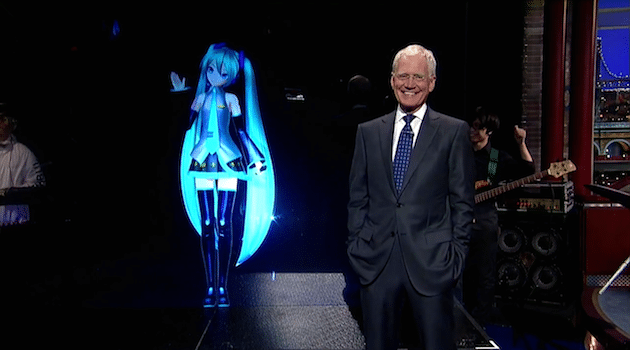Many of the science fiction movies portray scenes displaying holograms. Holographic humans and output technologies are a common thing. It has been quite a fascinating concept for a long time, it takes the attribute of being present to a whole new level by projecting a three-dimensional self- portrait into the existing physical medium. Doing all the presentable activities like walking, talking, interacting etc. Holography is a technique which enables three-dimensional images (holograms) to be made. It involves the use of a laser, interference, diffraction, light intensity recording and suitable illumination of the recording. The image changes as the position and orientation of the viewing system changes in exactly the same way as if the object were still present, thus making the image appear three-dimensional. To very wisely implement holography, Japan’s Crypton Future Media has developed a vocaloid named Hatsune Miku.
At only 16 years old, the Japanese pop phenom has already been seen nearly 88 million times on YouTube, regularly sells out shows around the world, and has even opened for Lady Gaga. She’s appeared in commercials for Toyota, Domino’s pizza, andGoogle Chrome among other brands, and according to the Verge, an entire social media network has been built around her popularity. There have been a lot of iconic musical moments during David Letterman’s tenure at the Ed Sullivan Theater, and now we can add another to the list that is the network television debut of Japanese virtual pop star Hatsune Miku. Hatsune is a Vocaloid that is a computer apparition that sings by processing melody and lyrics. Hatsune’s voice is sampled from Japanese voice actress Saki Fujita. The samples have been processed through several software programs, including Yamaha Vocaloid 2 and Vocaloid 3. She also uses Crypton Future Media’s Piapro Studio, a singing synthesizer VSTi Plugin. She was the second Vocaloid sold using the Vocaloid 2 engine, and the first Japanese Vocaloid to use the Japanese version of the Vocaloid 2 engine.
On April 30, 2010, a new add-on for Miku, called Hatsune Miku Append, was released containing a package of six different tones of Miku’s voice: Soft (gentle, delicate voice), Sweet (young, chibi voice), Dark (mature, heartbroken voice), Vivid (bright, cheerful voice), Solid (loud, clear voice), and Light (innocent, heavenly voice). Miku Append was created to expand Miku’s voice library, and as such requires the original program to be installed on the user’s computer first. This was the first time a Vocaloid had such a release, and more Append versions were reported from Crypton Future Media at later dates. Hatsune Miku has her own manga series, Hatsune Miku: Unofficial Hatsune Mix, and has made a number of appearances in other manga, and anime. Hatsune also has a video game series published by Sega, Hatsune Miku: Project DIVA. The latest in this series, Hatsune Miku: Project Diva f 2nd, will be released next month in the U.S. for the PlayStation 3, and PS Vita. Hatsune Miku has traveled an interesting path from vocal synthesizer product to beloved collaboratively constructed cyber celebrity with a growing user community across the world. For somebody who doesn’t exist, Miku has very tangible star power. She is the first cyber celebrity.

